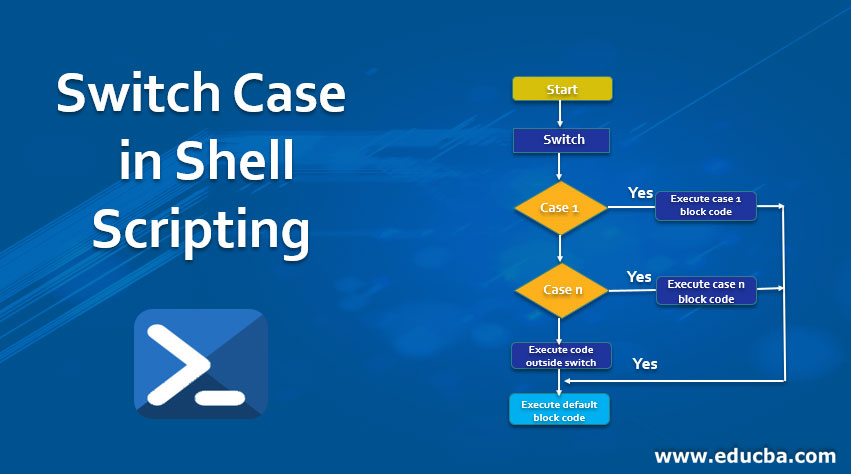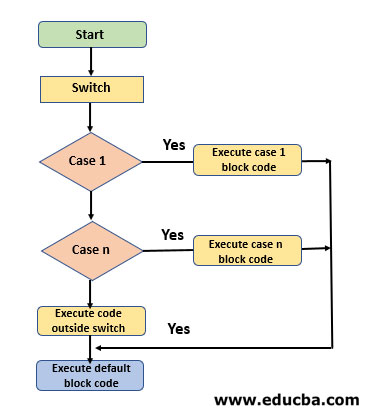Updated April 10, 2023

Introduction to Switch Case in Shell Scripting
When we need to perform multilevel checks we can use multiple if and else conditions or nested if-else branches but when we need to perform all conditional operations on a particular variable then it better to use switch case. In shell scripting switch case is represented using keywords case and esac which will do multilevel branching and checking in a better way than multiple if-else conditions. Switch case will need an expression which it needs to evaluate and need to perform multiple operations based on the outcome of the expression. So, we will use a switch case conditional statement when we want to perform different operations on the outcome of a single expression.
Syntax for Switch Case in Shell Scripting
The syntax for the switch case in shell scripting can be represented in two ways one is single pattern expression and multi-pattern expression let’s have a look now.
First Syntax Method
Now, we will have a look at the syntax of the switch case conditional statement with a single pattern.
Syntax:
case $var in pattern) commands to execute;;
pattern1) commands to execute;;
pattern2) commands to execute;;
pattern3) commands to execute;;
*)
Default condition and commands to execute;;
esacIn the above switch case syntax, $var in the pattern is a conditional expression if it evaluates to true commands corresponding to it will execute like that it will check for all conditional patterns if nothing satisfies or evaluates to true then commands in default condition will execute. The default condition is optional but it better to have it. When one condition matches then “;;” indicates control needs to go the end of the switch case statement.
Second Syntax Method
Now, we will have a look at the syntax of the switch case conditional statement with multiple patterns.
Syntax:
case $var in pattern|pattern1|pattern2) list of commands need to execute;;
pattern3| pattern4| pattern5) list of commands need to execute;;
pattern6) commands need to execute;;
*)
Default condition and statements need to execute
esacIn the above switch case syntax method, we are having a single $var comparing against multiple patterns with an or condition. If one of the condition matches it evaluates to true then corresponding statements will execute until the “;;” which indicates the end of that conditional statement. *) indicates the start of the default condition and statements need to execute and esac indicates the end of the switch case. We can include wild characters, regex in the patterns. The conditional check will happen continuously until it finds a pattern otherwise default statement will execute.
Flow Diagram for Switch Case
The flow diagram of the switch case in shell scripting is like below and we will explain with a simple example too. An example of the switch case statement is explained below.
Code:
fruit = "kiwi"
case $"fruit" in "apple") echo "apple is tasty";;
"banana") echo "I like banana";;
"kiwi") echo "Newzeland is famous for kiwi";;
*)
echo "default case";;
esacFlow Diagram:
In the above switch case example, we have a variable with kiwi as value and we have 3 patterns. It doesn’t satisfy or evaluates to true in the first 2 conditional statements and evaluates to true in the third conditional statement and executes the statement and control reaches the end of the switch case statement. In the above example first, conditional pattern is apple which is not equal to kiwi so it evaluates to false and second one is banana that also doesn’t matches and evaluates to false and the third statement is kiwi and it matches if it also doesn’t matches then it will execute default statement in the switch case and finally it comes to end of the switch case.
Output:
How Switch Case Works in Shell Scripting?
We have discussed already what a switch case, its syntax is. Now, we will see in detail how it will work in shell scripting. Initially, we initialize a variable with an expression or value and conditional statement checks whether it satisfies any condition, if yes then it will execute the corresponding commands until it finds the ;; which indicates the end of the commands of that condition. It will check the condition until it satisfies otherwise it will exit the switch case. If there is a default case then it will execute the commands in it instead of exiting from the switch case. Let’s have a simple example and see how it works as below:
Let’s have a simple example and see how it works as below:
Code:
mode = "jeep";
case $mode in “lorry") echo "For $mode, rent is Rs.40 per k/m.";;
"jeep") echo "For $mode, rent is Rs.30 per k/m.";;
*) echo "Sorry, I cannot get a $mode rent for you!";;
esacIn the above example, the variable mode is initialized with jeep and it checks all the conditions in switch case and executes the command which it satisfies and then it exits the switch case statement. In this case, it satisfies the condition jeep and executes the commands with a display message and comes out of the switch case statement.
Output:
Examples of Switch Case in Shell Scripting
Let’s have a look different at switch case examples and how they are working, what each example is trying to do with an explanation as follows.
Example #1
In this example, we are trying to tell the computer that it needs to do which backup based on the date.
Code:
NOW=$(date +"%a")
case $NOW in Mon) echo "Full backup";;
Tue|Wed|Thu|Fri) echo "Partial backup";;
Sat|Sun) echo "No backup";;
*) ;;
esacIn the above example, we assigned now with a day and we are checking the statements, here the day is assigned dynamically so the output of this program will change based on the day you execute this program. In this case, it will display partial backup as output.
Output:
Example #2
In this example, we are trying to know the fare of a vehicle based on its type like bike, jeep, bicycle, car etc.
Code:
mode = "bike";
case $mode in "sportscar") echo "For $mode, rent is Rs.20 per k/m.";;
"lorry") echo "For $mode, rent is Rs.50 per k/m.";;
"sumo") echo "For $mode, rent is Rs.30 per k/m.";;
"bicycle") echo "For $mode, rent is Rs. 5 per k/m.";;
*) echo "Sorry, I can not get a $mode rent for you!";;
esacIn the above example, we have a bike in the variable and checking against all the conditions but unfortunately, we didn’t find any match the conditions. So it will execute the default commands of the switch case and come out of it. In this case, it displays a sorry message.
Output:
Example #3
In this above let’s try to pass an argument to the shell script, and the argument will be compared against the conditions.
Code:
option="${1}"
case ${option} in -f) file="${2}" echo "file name is $file" ;;
-d) dir="${2}" echo "dir name is $dir" ;; *)
esacIn the above example, we will pass an argument to the shell script and according to the argument, it will execute either the file or directory by default it displays the usage of the shell script. If we pass –f and filename it displays the file name, etc.
Output:
Conclusion
Finally, it’s an overview of the switch case in shell scripting. So far we have discussed what is switch case, its syntax, how it works, its flow using a flow diagram and example, different examples to show use cases of switch case statement in shell scripting. I hope after reading this article you will have a better understanding of switch cases in shell scripting.
Recommended Articles
We hope that this EDUCBA information on “Switch Case in Shell Scripting” was beneficial to you. You can view EDUCBA’s recommended articles for more information.


